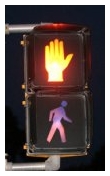
Sometimes I wish I never had to leave the house – even though “the house” is a small and light-deficient, though blissfully cool, basement apartment.
“Leaving” means going out into the din of air conditioners and leaf blowers (see yesterday’s post). It means walking past shop after shops selling plastic junk, $800 strollers.
It means sitting in Peet’s Coffee shop and observing  a woman grab at least 30 paper napkins, drop 10 of them on the floor, then on her way throw the 15 napkins she didn’t use into the trash. I’ve got one sticker for you, lady!

It means seeing three homeless people walk by, their belongings in plastic bags.
It means peering at a photograph in the Boston Globe, of about ten men in snow white kurtas, their beards and hair neatly trimmed, standing around a life-size doll of Salman Rushdie, barely alight yet on the ground. It means peering at their faces and knowing something of what they feel and think and see, but seeking something else. A knowledge, an understanding, but of what? I don’t know. I can’t find it.
“Going outside” now also means going onto the internet. It means reading this post on Casaubon’s Book and getting a lump in my throat (again). It is titled “We Simply May Not Have Time to Wait for the Technology Fairy”, and refers to this dire new report about climate change.
Sharon, who runs Casaubon’s Book, writes:
As far as I can tell, there is no better plan than this. Build soil. Plant trees. Grow food. Make Do. Do Without. Give what you can to others. Fix your mistakes. Cut your emissions to the bone, and then cut them some more. And every time it hurts (and it will sometimes), close your eyes and imagine your nieces and nephews or your children or grandchildren or your friend’s beloved children grown to womanhood and manhood in a world where there is food and peace and water. And then imagine them without. And ask yourself “What else don’t I need so I can bring about a decent future.”
That’s powerful writing.Â
Its first effect was that it made me berate myself. I lost track of that house with the acre of land, I stopped pursuing the volunteer position at a nearby farm, I stopped reading the books that matter, I got complacent, I was writing about leaf blowers, and concentrating too exclusively on my potboiler, which is one big piece of (fun) silliness…
It throws me into despair: is it useless, is it too late?
But then it galvanizes me. Ecological despair and hope for something better are not opposites, as long as there is action in between. Yes, there will be chaos, misery, and death. But at least there will still be something, and we can work to make that something a little less chaotic, less miserable, less deadly.
Action needs a guide and a spur, and there are many out there: personalities, exemplary lives, their books, etc. But I am a writer, so besides observing and learning from these heroes, I need to write my own manifest.
At first it will be for personal use, but once I have developed it – not in the least by living it – I want it to be a statement to friends, family and everyone else who wants and needs it.Â
Here is my work in progress, just begun, never-ending:
What do I have to do?
Preserve, not things,
But skills to make things
And skills to make the tools to make things
And the resources to make things
And the skills to preserve these resources
What do I have to build?
Soil, forests
strength, skill
community, hope
What do I have to learn?
Learn again what is necessary, what is not
And how to give and receive it
And how to live again with others
closely, in a natural, necessary bond
What should I leave behind?
What is not necessary
What is necessary?
Love and work, first of all
Beauty and rest, second
Community and hope, always.
Will these – just these – stand up?
They will.
Like a rock.
It needs something more, the really tough part:
What am I doing?
1. I am educating myself
2. I am making sustainable changes to my lifestyle
3. I am building the foundation for a better future
This should be more specific, of course.
-
Re-read and (today hopefully) review Coperthwaite’s A Handmade Life. Pursue again the volunteer position at the Farm.
-
HERE AND NOW list.
-
Investigate further the possibility of buying/leasing… that 1 acre.
 This Manifest will live on a page of its own.







 Â
Â